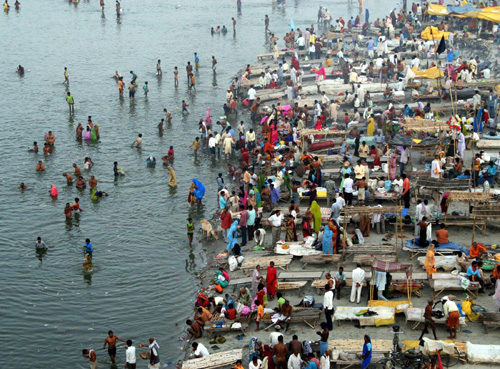Allahabad formerly known as Prayag , according to Hindu mythology, the creator god Lord Brahma chose a piece of land at which the three sacred rivers – the Ganga, the Yamuna and the 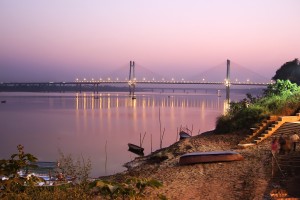 mythical Saraswati – would flow into a quiet confluence.That land, now known as Allahabad (“City ofGod”), is one of the most sacred pilgrimage destinations ofIndia.
mythical Saraswati – would flow into a quiet confluence.That land, now known as Allahabad (“City ofGod”), is one of the most sacred pilgrimage destinations ofIndia.
History of Allahabad
According to Hindu mythology, the land was chosen by Lord Brahma, the creator, for ‘Prakrishta Yajna’. Since then, the city was known as ‘Prayag’ and was believed to be blessed by gods. Foreseeing the sanctity ofAllahabad, the place was named as ‘Tirth Raj’ by Lord Brahma, which means King of all Pilgrimage Centres. Besides being a major pilgrimage centre, the city also holds an important position in the formation of modernIndia.
WhenAllahabadwas annexed in 1193 by Muhammad of Ghor, the city became a part of the Delhi Sultanate. In 1526, the Mughal invasion ofIndiabegan, after which the city became a part of their empire. Emperor Akbar foundedAllahabadby the name of ‘Illhabas’ in 1575 AD, meaning the City ofAllah, which has now becomeAllahabad.
During the medieval period, this holy city ofUttar Pradeshenjoyed the honour of being a religio-cultural centre ofIndia. For a long period, the city was the provincial capital of the Mughals, which was later captured by the Marathas.
The British history ofAllahabadbegan in 1801 AD, when the Nawab of Oudh ceded the city to the British throne. The famous Allahabad Fort, constructed by Akbar, was used by the British army for their military purposes.
By 1857 AD, the city became the centre of the war ofIndependenceand thus played a crucial role in the Indian Freedom Movement against British Rule. In 1858 AD,Indiawas officially handed over to the British Government by the East India Company. After the first War of Independence, the city was made the capital of the United Province of Agra andOudh.
Thus, the city was the heart of the Indian Freedom Movement with Anand Bhawan being its epicentre. It was in this beautiful city that the Father of the Nation, Mahatma Gandhi proposed his program of non-violent resistance against the British to liberateIndia.
Location
Allahabad (lat 25.435885 lon-81.846431) is one of the oldest cities inIndia. It is located 135 km west ofVaranasi, at the confluence ofIndia’s two most important rivers-the Yamuna andGanges. It is 585 km southeast ofDelhi and 160 km south of Ayodhya. The main spiritual reason for coming here is to take bath in the Sangam, to confluence (where rivers meet), of the Yamuna, Ganges, and the undergroundSaraswatiRivers. It is one of the major pilgrimage sites in all ofIndia.
Places to visit
Holy Ganga
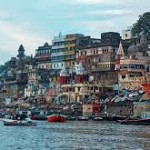 The holiest of all the rivers, Ganga or the Gangesis a perennial river, which is held in high regard by the Hindus. The Gangariver has an exalted position in the Hindu ethos.
The holiest of all the rivers, Ganga or the Gangesis a perennial river, which is held in high regard by the Hindus. The Gangariver has an exalted position in the Hindu ethos.
The Gangotri Glacier, a vast expanse of ice five miles by fifteen, at the foothills of the Himalayas (14000 ft) in north Uttar Pradesh is the source of Bhagirathi, which joins with Alaknanda (origins nearby), to form Ganga at the craggy, canyon-carved town of Devprayag.
Sangam Bath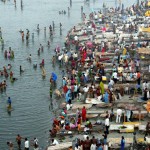
This is where theGanges, Yamuna and Saraswati meet. This place is considered to be the most important holy bathing place inIndia. The muddy-coloredGangesin shallower and more rapid. The Yamuna is bluer and deeper. The most auspicious time to bathe in the Sangam is during Kumbha -mela. It is also especially auspicious to bathe here during the month Magh (January-February).
Allahabad Fort
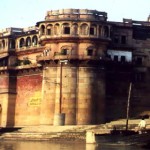 Allahabad Fort that stands on the northern banks of Yamuna near the confluence is a must visit destination in Allahabad. Emperor Akbar himself commissioned this magnificently designed fort in the year 1583. There was a time when this fort was considered among the best garrisons in the entire Mughal Empire but little is left of that grandeur today. The fort has massive walls and three gateways that are flanked by high towers. The magnificent outer wall is still intact and rises above the water’s edge.
Allahabad Fort that stands on the northern banks of Yamuna near the confluence is a must visit destination in Allahabad. Emperor Akbar himself commissioned this magnificently designed fort in the year 1583. There was a time when this fort was considered among the best garrisons in the entire Mughal Empire but little is left of that grandeur today. The fort has massive walls and three gateways that are flanked by high towers. The magnificent outer wall is still intact and rises above the water’s edge.
This masterpiece of craftsmanship has now been taken by the army and serves as a barrack now a days but a substantial part of the fort is still opened to the visitors. The most interesting structure in the fort is Ashoka Pillar that was earthed by the order of the Great Mauryan King, Ashoka in 232 BC. Its inscription eulogizes the victories of Samudragupta, the Napoleon of India. It also contains usual edicts that were there since the times of Ashoka.
Apart from that, you have very famous but controversial Saraswati Kund that is supposed to be the source of mythical river Saraswati. Nevertheless, historians and geologists heavily contest these claims. Jodhabai Mahal is another attractive monument. This palace is bound to catch your fancy because of its subtle design that has been developed due to the fusion of Hindu as well as Islamic architecture pattern. The Patalpur temple and the much-revered Akshaya Vat (immortal Banyan tree) are also there to see.
Anand Bhawan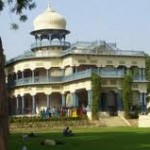
Anand Bhavan is the ancestral home of Jawaharlal Nehru, the freedom fighter and the first Prime-Minister of India. The place is also house of Indira Gandhi, the “Iron Lady of India”. The place has today been turned into a museum. The importance Allahabadalso increases because of the fact that many momentous decisions and events, related to the freedom struggle took place here. The main building houses a museum that displays the memorabilia of the Nehru family
Khusrau Bagh
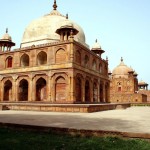 Khusrau Bagh is close to Allahabadrailway station. It is a must visit tourist destination in Allahabad. The park has a historical significance. That is because; this park houses the tomb of Prince Khusru who was one of the sons of Emperor Jahangir.
Khusrau Bagh is close to Allahabadrailway station. It is a must visit tourist destination in Allahabad. The park has a historical significance. That is because; this park houses the tomb of Prince Khusru who was one of the sons of Emperor Jahangir.
This scrappy walled garden houses the tomb of the prince who was brutally executed in the war of succession. Khusrau and Khurram were the two sons of Jahangir. When fight for succession followed, it is said that Prince Khurram eliminated Khusrau, his half-brother and wrested the power from his father. Prince Khurram grew up to become Shah Jahan who commissioned Taj Mahal in the memory of his deceased wife.
Nearby is the unoccupied tomb that was intended for his sister. There is another tomb that belongs to Khusrau ‘s mother, who had poisoned herself in despair at Khusrau’ s oppositon of his father Jahangir.
Allahabad Museum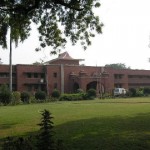
Allahabad Museum is one of the best-kept museums inIndiaand that is what makes it a must visit destination inAllahabad. The specialty of this museum lies in the fact that it has separate galleries devoted to archaeological findings, natural history exhibits, art gallery and artifacts donated by Jawaharlal Nehru.
HanumanTemple
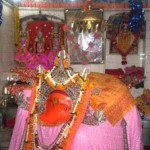 Hanuman is in a reclining posture, a few feet below the ground, instead of his usual standing posture. It is said that every year theGanges floods until it touches the sleeping Hanuman’s feet and then it starts receding.
Hanuman is in a reclining posture, a few feet below the ground, instead of his usual standing posture. It is said that every year theGanges floods until it touches the sleeping Hanuman’s feet and then it starts receding.
This temple is located by the Sangam side of the Fort and is busy small temple open to non-Hindus. There are nice carvings on the nearbySriAdhiShankaraTemple, which has a Sri Tirupati Balaji Deity.
PatalpuriTemple (Undying Tree)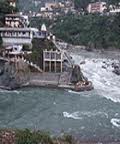
It is located through a small doorway, in the wall of the fort, on the way to the boats that go to the Sangam. It is an underground temple with many different deities carved in stone. The Akshayavata Tree is said to never die, even when the entire world is destroyed. It is located in the underground temple. The tree is on a deep niche, above an underground hole that is said to lead to the Triveni.
Bharadwaja Ashram
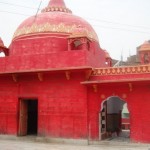 This ashram is mentioned in the Ramayana.AllahabadUniversity now occupies the place where the ashram of Bharadwaja Rishi and his 10,000 disciples is said to have been located. There are the temples of Bharadwajeswara Mahadeva, Rishi Bharadwaja, and Kali here. It is said that Lord Rama and Sita visited this place when they began Their 14-year exile.
This ashram is mentioned in the Ramayana.AllahabadUniversity now occupies the place where the ashram of Bharadwaja Rishi and his 10,000 disciples is said to have been located. There are the temples of Bharadwajeswara Mahadeva, Rishi Bharadwaja, and Kali here. It is said that Lord Rama and Sita visited this place when they began Their 14-year exile.
Sri Rupa Gaudiya Math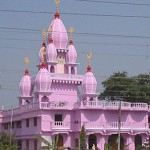
There is a Gaudiya Math temple, the Sri Rupa Gaudiya Math, on South Mallaca Street, in the Madhavapur area. This temple is by the Ganges River on the way to the Sangam from downtown. Srila Prabhupada took initiation here from Srila Bhaktisiddhanta Saraswati Maharaja.
PLACES AROUND ALLAHABAD
Situated 9 km from Allahabad, Jhusi (Pratisthanpuri) is a place for people wanting peace of mind and soul. It has many ashrams and temples and can be reached from Allahabadby taxis, buses, and boats, etc.
Kaushambi (62 km) is a place traditionally associated with the Mahabharata. The city was once a great Buddhist center. Lord Buddha is believed to have visited Kaushambi twice to deliver discourses. The ruins of an ancient fort bear witness to the antiquity of the place. There are also remains of a monastery.
Bhita (20 km) is an archeological site with remains dating back to 300 BC.
Shringverpur (40 km) was once the capital city of the kingdom of Nishadraj (King of Boatmen). Legend has it that Lord Rama stayed here overnight while going to the forest. Before steering Rama across the Ganga in his boat, his feet were washed by Nishadraj.
Other places that can be visited are Tons river aqueduct, Kara, andUpardahaLake
Festivals and Events
“Mela” means “festival” in Hindi. The Magh Mela takes place every year in the month of Magh (January-February) of the Hindu calendar.
The Kumbha Mela takes place every 12 years and has more significance than the Magh Mela. These fairs take place on the banks of the holy riverGanga. In the Kumbha Mela of 2001, almost 75 million people visited the banks ofAllahabad’s rivers to take part in the festivals.
During the Melas, entire temporary townships are built atAllahabad, including functioning hospitals, fire stations, police stations, restaurants and other facilities.
HOW TO REACH?
BY AIR – Allahabad does not have an airport of its own. The nearest airports are at Varanasi (147 km) and Lucknow (210 km).
BY ROAD & RAIL -Allahabad is situated on the Delhi-Calcutta route and can be reached from any part ofIndia by rail or bus. We would provide you allIndia tourist permit vehicles for the local transportations and also for the intercity drives too.
Important Facts-
| Climate: | Summer 43°C to 30°C, Winter 25 °C to 3 °C |
| Best time to visit: | October to March |
| Area: | 63.07sq, km |
| Altitude: | 98 m above sea level |
| Must Visits: | Anand Bhawan, Sangam andMintoPark |
| Language spoken: | Hindi, Urdu and English |
| STD Code: | +91-532 |
Submit your review | |
